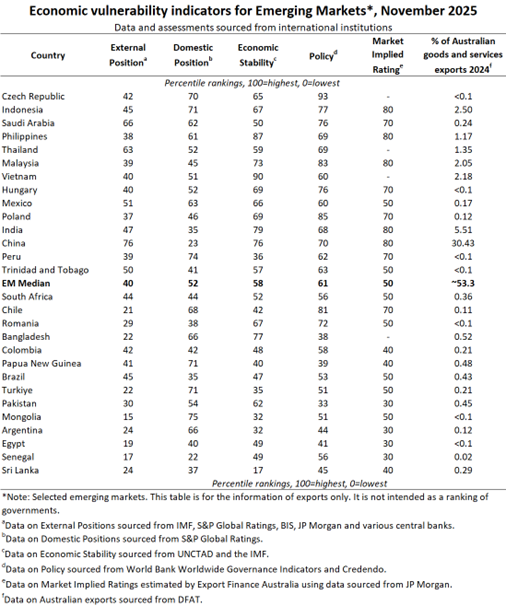© Export Finance Australia
The views expressed in World Risk Developments represent those of Export Finance Australia at the time of publication and are subject to change. They do not represent the views of the Australian Government. The information in this report is published for general information only and does not comprise advice or a recommendation of any kind. While Export Finance Australia endeavours to ensure this information is accurate and current at the time of publication, Export Finance Australia makes no representation or warranty as to its reliability, accuracy or completeness. To the maximum extent permitted by law, Export Finance Australia will not be liable to you or any other person for any loss or damage suffered or incurred by any person arising from any act, or failure to act, on the basis of any information or opinions contained in this report.
Major export markets—Economic strength bolsters resilience to risks
The IMF expects GDP growth in emerging markets (EMs) to drop from 4.3% in 2024 to 4.2% in 2025 and 4.0% in 2026 as global trade growth slows sharply amid persistent fragmentation and protectionism. Domestic-focused economies, such as India and Indonesia, are more insulated, while export-led economies differ based on reliance on US export markets, relative tariff rates and general price competitiveness. The outlook for EMs is supported by improved domestic institutions, favourable external financing conditions, private sector adaptability and deepening intra-regional cooperation. However, downside risks are large and widespread. Global growth could disappoint due to a) continued trade policy uncertainty weighing on consumption and investment, b) fiscal vulnerabilities and financial market fragilities which threaten stability, and c) renewed volatility in commodity prices that harms commodity-dependent economies.
International institutions and financial market analysts, including the IMF, World Bank and S&P Global, use a range of indicators to assess vulnerability to these risks.
- External position—what is the external debt and reserves position? Is the current account in deficit and how far has the currency deviated from its long-term average?
- Domestic position—how leveraged is the private and public sector?
- Economic stability—what is the growth and inflation outlook? How reliant is the country on commodity exports, given the volatility in global commodity prices?
- Policy effectiveness—how effective is the regulatory environment and how severe are political risks?
- Market implied ratings—what do market risk premiums on foreign currency denominated bonds imply about market risk appetite?
According to these measures, many of Australia’s major EM export markets—such as Indonesia, Philippines, Thailand, Vietnam and Malaysia—are well placed (Table), benefiting from relatively robust domestic consumption and a competitive manufacturing export base. Global supply chains are unlikely to shift away from these economies, which supports external stability, foreign investment, and broader financial stability, amid moderate debt burdens. Rising incomes, favourable demographics and business-friendly reforms help reduce vulnerabilities in many of these economies.
China and India also remain above the EM median. While China and India have been subject to large US tariff increases, both economies are less reliant on US goods demand than Asian peers. India is expected to remain the world’s fastest growing major economy—supported by policy easing, service sector expansion and infrastructure development—while solid reserve buffers bolster resilience to external shocks. This is balanced against India’s high public debt and low revenue generation, a weak but improving financial sector and lagging structural issues. China’s continued, albeit slowing, economic growth is supported by incremental policy stimulus. However, the struggling property market, weak consumer confidence, ongoing deflation, overcapacity and geopolitical tensions are raising economic vulnerabilities.
Other major export markets sit below the EM median. For instance, while PNG is making strong progress on reforms under its IMF program, economic vulnerabilities remain high and downside risks include volatile commodity prices, natural disasters and political and social instability. Meanwhile, Pakistan and Bangladesh are gradually recovering from political instability that dented public and external finances, prompting the IMF to agree packages to shore up economic and financial stability.

